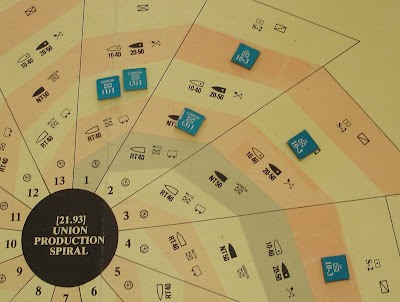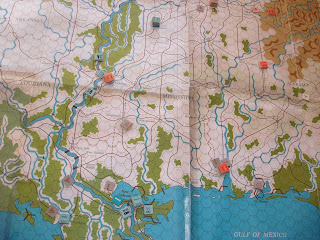Union production for the 13/63 cycle was to augment a 3-3 infantry division to a 10-3
and with the remaining 3 personnel points build a 3-1 garrison.
The Confederates built a 10-1 garrison.
Under their special replacement rule this can add to their infantry divisions in the field.
The turn starts well for the Union when Burnside throws off the forces besieging him at Fort Monroe.
It then goes bad when the rebels besiege Washington.
In the previously exciting Eastern Theatre,
nothing much is happening.
Sherman has his eyes on Nashville and the Confederates have their eyes on Memphis.
Meade saves Washington,
but now Baltimore is threatened.
After a brief move towards Nashville,
Sherman pulls back to Memphis.
The East Coast is unchanged.
If anything The Union are asking why they bothered.
The Confederates have an abundance of supplies.
Plus they are not having to spend resources when they add garrison factors to their infantry divisions.
Down in the Gulf, the siege of New Orleans continues.
The situation in the East has stabilised.
For the 13/63 cycle the initiative chits for the Union had been 4, 1, 1, 4 against a steady 3 for the Confederates. Losses were 16 for the Union and 7 for the Confederates.
Union is reduced to building garrisons.
As is the Confederates.
But as noted, they can convert their garrisons troops to regular infantry,
without cost.
This effectively means they have double the manpower.
Lee strikes at Baltimore.
Meade rescues Baltimore (on his third attempt I should say),
only to see Washington besieged again.
The Confederates are able to bring reinforcements (i.e. their freshly built garrison troops)
north to replenish Lee's losses as he attempts to storm the fortress guarding Washington.
The Confederates ports have been reduced to three,
but it has negligible impact on their resources.
Schofield has taken Brashear for the Union,
another port, but one that was isolated since the siege of New Orleans.
A siege that is now in it's fourth month.
Sherman is on the move.
For the 1/64 cycle the initiative chits for the Union had been 2, 4, 4, 2 against a steady 3 for the Confederates. Losses were 28 for the Union and a staggering 51 for the Confederates. Trying to storm fortifications is a costly business.
The critical thing with the Confederates threatening Washington and or Baltimore is that they gain a political point each cycle for it. With the slow progress of the siege of New Orleans, it is looking very grim for the Union.


















Such an interesting situation! Lee is keeping the Federals dancing the Baltimore-Washington two-step!
ReplyDeleteIt literally has been round and round.
DeleteThis is not good news for the Union - Rebs at the gates of Washington, time to bring back the Young Napoleon!!!
ReplyDeleteLack of good Union commanders is one thing, but they are really low on manpower.
Delete